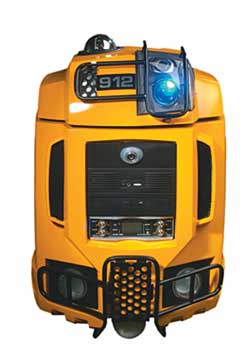Domo Arigato, Mr. Roboto!
Coming in 2006, this little guy uses positive reinforcement to promote safe work practices.
- By Marc Barrera
- Jan 01, 2006
 IT'S a hot, blistering day on the construction site. A worker stops to notice
an attractive lady walking by confidently. She's secretly ready to barrage him
with a stream of obscenities at the first sound of a whistle and sure enough,
one rings clearly above the construction din. In a flash the woman stops in her
tracks and turns to seek out her offender. But it isn't the worker--it's a small
robot no taller than her knees. And it wasn't addressing her; it was whistling
at one of the workers! Ego bruised, the woman storms off. There are plenty of
other construction sites.
IT'S a hot, blistering day on the construction site. A worker stops to notice
an attractive lady walking by confidently. She's secretly ready to barrage him
with a stream of obscenities at the first sound of a whistle and sure enough,
one rings clearly above the construction din. In a flash the woman stops in her
tracks and turns to seek out her offender. But it isn't the worker--it's a small
robot no taller than her knees. And it wasn't addressing her; it was whistling
at one of the workers! Ego bruised, the woman storms off. There are plenty of
other construction sites.
Meet SafetyBotTM, a lightweight roving robot
that isn't just wolf whistling. In fact, this little guy rewards workers for
using safe work practices. It is the latest innovation from Columbia, S.C.-based
Bill Sims Co., creator of many safety incentive programs.
Keeping in Compliance
Safety managers participating in a Bill Sims
program give workers a "You Did It Right!" card when noticing a safe work
practice. The card contains a checked-off list of actions for which the worker
is being recognized. Employees would then have to log onto the program network
through the Internet, their company's intranet, a phone call, or a StarKiosk to
see what level of prize is awarded. That prize is then added to the worker's
account until the worker is ready to cash it in for a selection of prizes from
the Award of Excellence catalog.
SafetyBot is designed to remove all of these inconveniences. "It roams across
the construction site. It's about the size of R2D2. It whistles at people, it
gets their attention," said Bill Sims Jr., president of the Bill Sims Company.
"Instead of waiting for you to find it in the breakroom, it's going to find you.
When you get a 'You Did It Right!' card from your safety manager, you just take
it over to SafetyBot, log it in, and get a prize."
At the same time, SafetyBot will make sure the employee is up to code on the
latest safety compliance instruction and testing. Safety is a constantly
changing field, with new codes and regulations always on the forefront. Once a
worker provides an ID number, the robot can give any necessary instruction that
worker hasn't received, followed by a test to ensure the information was
retained. All of this information will be logged and saved for company records.
When the employee has fulfilled a compliance requirement, SafetyBot adds an
award of its own that goes directly to the worker's account. The robot then
moves on, seeking out other workers to whistle over.
TV That Makes You Smarter
In addition to keeping workers in
compliance, SafetyBot can keep them informed with the "Safe TV" concept. The
robot's touch screen can be used to display the latest company information as it
roams a site and interacts with workers. "There's all kinds of safety things and
quality messages that these managers need to get across to their employees,"
Sims said. "The safety manager can select what he wants to flash up. He can have
a little bit of CNN news pop up for 20 or 30 seconds, get the headlines out
there. He can toggle it back to another Web site that would flash up."
Remote Patrol
Beyond such autonomous functions, SafetyBot also comes
with what Sims calls a "telepresence" option, which allows the Bill Sims team to
further help safety managers perform their duties.
"Even though we are in South Carolina, we'll be able to be at your business
and remote-control SafetyBot around your plant and look for people doing things
safely and talk to them," Sims said. "It's an emerging field of robotics where
we will actually be in the plant without physically being there."
This option allows SafetyBot not only to reward good safety behavior, but
also help to stop any unsafe worker practices the robot's operator may notice.
"Whether it's a human that notices or whether it's a robot, I don't think the
employee cares, as long as this little robot comes up to him . . . and says,
'Hey, you lifted incorrectly, how about doing it this way next time?'" Sims
said.
Sims doesn't rule out the eventual possibility of having this option
available autonomously. "That would require a level of intelligence beyond what
the robot can do," he said. "For a robot to be able to see [you] lifting
correctly or incorrectly and stop you and tell you . . . that probably will
happen down the road, but it is probably a generation or two of software
upgrades [removed]."
The SafetyBot is currently in development. Sims said the company plans to
debut it in 2006. "It's in the works, in the pipeline--it's coming," Sims said.
"We hope to be able to have a demo of SafetyBot at our next trade shows this
summer."
This column appeared in the January 2006 issue of Occupational Health
& Safety.
This article originally appeared in the January 2006 issue of Occupational Health & Safety.